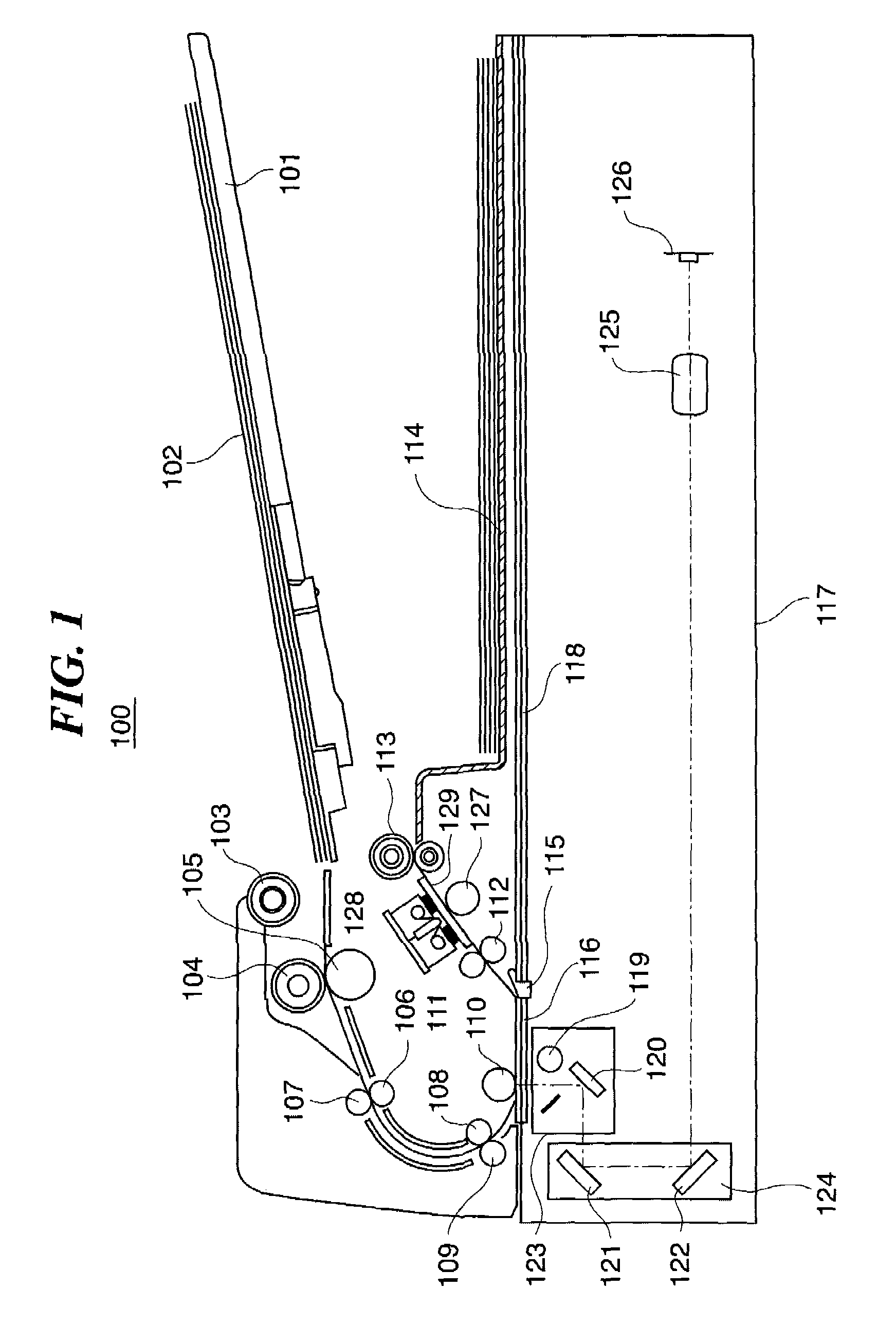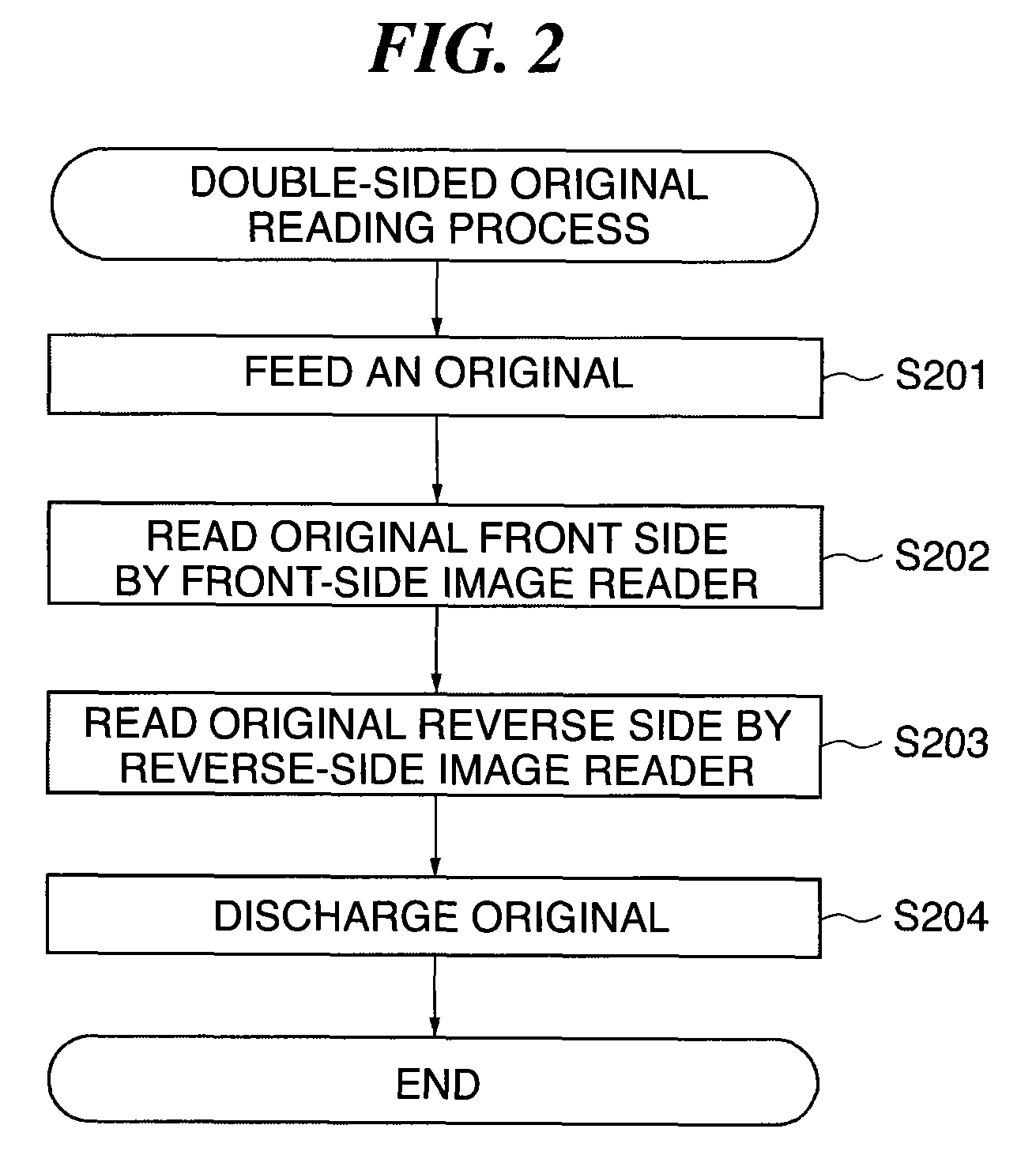Image reading apparatus and image reading method
a reading apparatus and reading method technology, applied in the field of image reading apparatus, can solve the problems of insufficient light to cope with the reading of such a security document, variable light amount used for double-sided original reading, and correction techniqu
- Summary
- Abstract
- Description
- Claims
- Application Information
AI Technical Summary
Benefits of technology
Problems solved by technology
Method used
Image
Examples
first embodiment
[0051]FIG. 1 is a view of an image reading apparatus according to the present invention.
[0052]As shown in FIG. 1, the image reading apparatus is comprised of an automatic document feeder 100, and an image reading apparatus main unit 117.
[0053]FIG. 2 is a flowchart of a double-sided original reading process executed by the image reading apparatus shown in FIG. 1.
[0054]In the following, the arrangement of the image reading apparatus will be described together with operations shown in FIG. 2.
[0055]First, originals 102 are stacked on an original tray 101 of the automatic document feeder 100. A sheet feed roller 103 is disposed above the front end of the original tray 101. The sheet feed roller 103 is connected to the same driving power source as a separating and conveying roller 104 is, and rotates along with rotation of the driving power source to feed each original (step S201).
[0056]The sheet feed roller 103 is normally in to a retracted home position above the front end of the origin...
third embodiment
[0120]Next, a third embodiment will be described with reference to FIGS. 15 to 17. In the present embodiment, a description will be given of matching of in-surface reading characteristics and front-side and reverse-side reading characteristics in a case where two patches are selected from each of the low-density portion and the high-density portion, i.e. in a case where four patches are selected. More specifically, the description will be given of a case where a patch with a density of 0.15 and a patch with a density of 0.45 are selected from the low-density portion, and a patch with a density of 1.00 and a patch with a density of 1.79 from the high-density portion, for matching over in-surface reading characteristics and between the front-side reading characteristics and the reverse-side reading characteristics.
[0121]FIG. 15 is a conceptual view of four-point correction of the density linearity characteristic.
[0122]As is understood from FIG. 15, in the case of correcting the densit...
fourth embodiment
[0129]Next, a fourth embodiment will be described with reference to FIGS. 18 and 19.
[0130]In the above-described first to third embodiments, the method of matching the reading characteristics in the main scanning direction or between the front-side and reverse-side reading characteristics was described in detail.
[0131]Actually, however, even patches with the same density can cause large differences in the reading characteristics depending on the conditions of an original surface, i.e. depending on whether the original surface is glossy and “slippery” or non-glossy and “rough”.
[0132]FIGS. 18A and 18B are diagrams showing a density linearity characteristic in a case where an original has gloss and a density linearity characteristic in a case where an original has no gloss.
[0133]FIG. 18A shows the density linearity characteristics in the whole density range, and FIG. 18B shows the high density range thereof on an enlarged scale. As is understood from FIGS. 18A and 18B, the density line...
PUM
| Property | Measurement | Unit |
|---|---|---|
| density | aaaaa | aaaaa |
| reflectance-read luminance | aaaaa | aaaaa |
| reflectance | aaaaa | aaaaa |
Abstract
Description
Claims
Application Information
 Login to View More
Login to View More - R&D
- Intellectual Property
- Life Sciences
- Materials
- Tech Scout
- Unparalleled Data Quality
- Higher Quality Content
- 60% Fewer Hallucinations
Browse by: Latest US Patents, China's latest patents, Technical Efficacy Thesaurus, Application Domain, Technology Topic, Popular Technical Reports.
© 2025 PatSnap. All rights reserved.Legal|Privacy policy|Modern Slavery Act Transparency Statement|Sitemap|About US| Contact US: help@patsnap.com



